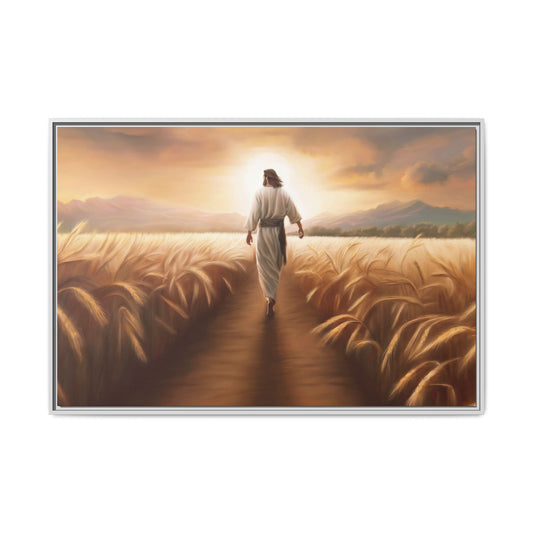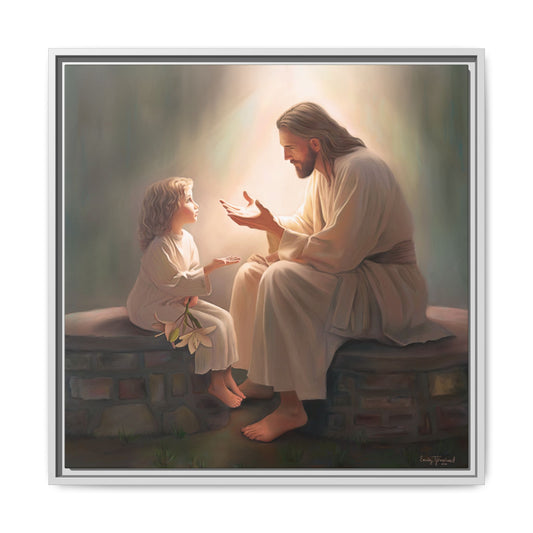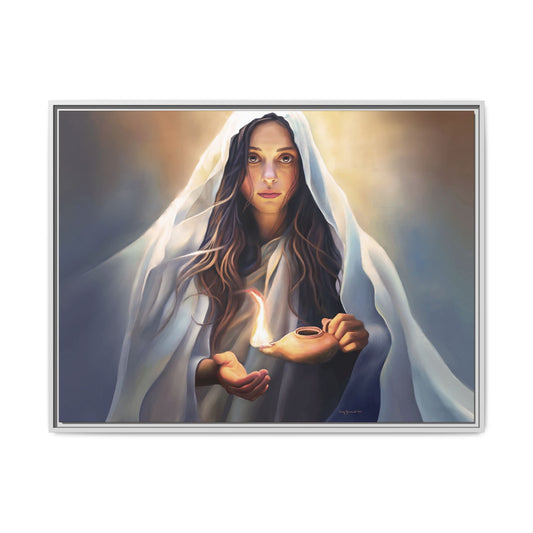Is Jesus Art Portrayed as Middle Eastern
Share
Have you ever wondered how Jesus has been portrayed in art throughout history? Is Jesus art portrayed as Middle Eastern?
We have explored this question from a range of perspectives, from the early spread of Christianity to the origins of early Christianity and Jesus in early Christianity. We will look at the evidence from the Eastern Roman Empire and the centers in Antioch, Alexandria, and Constantinople to better understand how Jesus has been depicted.
Join us as we examine the controversy and debates surrounding the depiction of Jesus in art and the worshipful expressions of Jesus portraits throughout history.
Key Takeaways
- There is no agreement among scholars on Jesus' appearance, and depictions of Jesus have varied throughout history.
- The average Judean of Jesus' time likely had brown or black hair, honey or olive-brown skin, and brown eyes. Jesus likely had short hair and a beard according to Jewish practices.
- Biblical references to Jesus' appearance are limited, with no descriptions of his appearance before his death. The transfiguration and the Book of Revelation depict Jesus in glorified or heavenly form, not his earthly appearance.
- Early theories and literary traditions on Jesus' appearance include descriptions of him as physically unattractive, small, ignoble, and lacking good looks. Theological perspectives argue that Jesus must have been ideally beautiful.
Evolution of Jesus Portraits
We have seen a wide range of depictions of Jesus in art throughout history, from early representations to modern depictions.
In this article, we'll explore how Jesus' image has evolved over time, from the Renaissance period to the present day, and examine the impact of westernization and diversification on his portrayal.
Early Representations of Jesus in Art
Early Christian art often depicted Jesus with an ambiguous appearance. But over time, cultural influences began to shape the representation of Jesus in art.
We can observe these influences in the evolution of Jesus portraits. The early portrayals were anonymous figures found in the Roman catacombs. These figures lacked distinct features and instead focused on conveying spiritual meaning.
However, as Christianity spread and interacted with different cultures, changes began to emerge in the depiction of Jesus. In regions where Hellenistic culture dominated, Jesus started to be depicted with more idealized features, resembling Greek gods. This reflected the influence of the artistic conventions of the time.
Similarly, in regions influenced by Byzantine culture, Jesus began to be portrayed with a regal and majestic appearance, reflecting the political and religious power of the Byzantine Empire.
These cultural and political influences continued to shape the representation of Jesus in art throughout history. As different artistic movements emerged, such as the Renaissance or Baroque periods, artists brought their own interpretations and styles to the portrayal of Jesus.
Iconography in Early Christian Art
From the earliest days of Christianity, numerous representations of Jesus have been created in art, often depicting him in Middle Eastern attire. Iconography in early Christian art evolved over time, depicting Jesus in a Judean, Semitic form. This was followed by portraying him as an idealized, heavenly figure. The art then began presenting him as a spiritual leader and teacher, emphasizing Christ's divinity and universal appeal. Jesus is typically portrayed as a Middle Eastern figure to reflect his cultural and historical context.
The use of Middle Eastern iconography in Christian art serves to remind us of Jesus' mission to serve the marginalized. It also reflects the connection between Christianity and Judaism.
Cultural Influences in Early Depictions of Jesus
As we explore the evolution of Jesus portraits in art, it's clear that cultural influences have heavily impacted early depictions of Jesus. Cultural settings, political circumstances, and theological contexts have all had a role to play in the way Jesus has been represented in art.
Middle Eastern features have been prominent in many depictions, reflecting the Judeans of the time who were biologically closer to Iraqi Jews. Moreover, the biblical terminology for race doesn't provide clear descriptions of Jesus' appearance.
Ultimately, these cultural influences have shaped the way we view Jesus and his message in the present day. With this in mind, it's time to explore the renaissance era and the westernization of Jesus.
Renaissance Era and the Westernization of Jesus
During the Renaissance period, Jesus' portraiture was increasingly influenced by European art, resulting in a shift away from Middle Eastern depictions of Jesus.
This phenomenon was driven by the cultural and artistic changes of the period, which sought to emphasize the gentility and nobility of Jesus.
Consequently, Jesus' portraits began to take on more westernized features, such as lighter skin tones, blond hair, and European-style clothing.
Cultural and Artistic Changes That Influenced the Portrayal of Jesus
Throughout the Renaissance, we've seen a significant shift in the cultural and artistic depiction of Jesus, often leading to a Westernization of imagery. Christians around the world began to re-imagine Jesus' image, with some painting him with European features: fair skin, light hair, blue eyes, and a tall stature.
This was often in contrast to Jesus' likely Middle Eastern roots. As a result, Jesus' image was altered to match the cultural and religious context of the time.
This shift in Jesus' image has been an ongoing process driven by local contexts and the desires of the Christian community.
Impact of European Art on Jesus Portraits
We have seen a dramatic change in the art of depicting Jesus over the past few centuries, especially in the Renaissance, as European art began to heavily influence the portrayal of Jesus.
Christian art from this era began to portray Jesus in a more European-looking way, with lighter skin, blue eyes, and blonde hair. This was a drastic departure from the historical evidence which suggests Jesus was likely a Middle Eastern man with olive-brown skin, dark hair, and brown eyes.
This shift in Jesus' physical appearance is likely due to the Westernization of Jesus, as European culture began to dominate the Christian faith.
Modern Depictions and Diversification
We have seen how Jesus' appearance has been depicted throughout the centuries.
But what about modern portrayals?
In recent years, contemporary artists have been challenging traditional portrayals of Jesus.
They emphasize the importance of diverse representations of Jesus from different cultures around the world.
Representation of Jesus in Various Cultures Around the World
From the early days of Christianity to the present, representations of Jesus around the world have evolved and diversified. From the Middle East, where his story originated, to churches and other cultural contexts, Jesus has been depicted in a variety of ways.
1) In the Middle East, Jesus is often depicted as a Middle Eastern man.
2) In church settings, Jesus is usually portrayed as white.
3) In other cultures, Jesus is often represented as a person of the same ethnicity as the majority.
4) For many, Jesus transcends racial and cultural boundaries, representing a universal savior.
Contemporary Artists Challenging Traditional Portrayals
With a growing number of contemporary artists challenging traditional portrayals of Jesus, we see the evolution of Jesus portraits diversifying into modern depictions. We now observe a greater diversity in the ways in which Jesus is represented in art, with works exploring themes such as God's unconditional love and the Israel of the Bible.
Many of these works strive to create an image of Jesus that people can relate to, one that speaks to the modern world and its challenges. As a result, we're presented with a wide range of interpretations of Jesus, from the traditional to the abstract.
The Importance of Diverse Representations of Jesus
Building on the discussion of contemporary artists challenging traditional portrayals of Jesus, it's important to recognize the importance of diverse representations of Jesus in art. We must consider:
1) Race and appearance of Jesus throughout history.
2) Biblical references to Jesus' appearance.
3) Literary traditions on Jesus' appearance.
4) Documents and references on Jesus' appearance.
In this way, we can recognize the importance of understanding Jesus as a historical figure in the Middle Eastern context.
Understanding Jesus as a Historical Figure
By exploring the portrayal of Jesus in the Bible and historical accounts, we can gain a better understanding of his Middle Eastern origins and cultural context.
Through an analysis of the literary traditions around Jesus' appearance, documents and references to Jesus' appearance, and biblical references to Jesus' appearance, we can gain insight into how Jesus has been depicted throughout history.
Jesus' Middle Eastern Origins and Cultural Context
Jesus' Middle Eastern origins and cultural context are of critical importance to understanding him as a historical figure. Evidence exists to support the idea that Jesus was from the Middle East, and certain aspects of his life and teachings can be better understood when viewed through a Middle Eastern cultural lens.
Knowing more about Jesus' cultural and religious background can help us to appreciate his unique message and the impact it had on the world.
The Significance of Jesus Being from the Middle East
We understand the significance of Jesus being from the Middle East by exploring his historical context and origins. Jesus, born to a Jewish family, was part of a culture and story that has been passed down to us through the gospel.
His Middle Eastern cultural context brings us:
- An understanding of his teachings and insights
- A connection to his family and ancestors
- Knowledge of his cultural practices
- A deeper appreciation of the gospel message.
Historical Evidence Supporting Jesus' Middle Eastern Heritage
Drawing on ancient documents, archaeological finds, and biblical references, we can examine the historical evidence that supports Jesus' Middle Eastern heritage. From Old Testament passages to the Book of Revelation, faith, history, and life are intertwined to provide insight into Jesus' origins.
The Letter of Lentulus, thought to be a forgery, and the Epiphanius Monachus' description of a tall angelic figure are just some examples of documents that offer clues to Jesus' appearance. Scholars continue to explore the cultural and theological contexts of Jesus' time to better understand his connection to the Middle East.
Exploring the Portrayal of Jesus in the Bible and Historical Accounts
We explore the depiction of Jesus in the Bible and historical accounts. Firstly, we focus on descriptions of Jesus' physical appearance mentioned in the Bible. Secondly, we examine depictions of Jesus in historical texts. Finally, we discuss the importance of historical accuracy when representing Jesus.
---
In the Bible, there are few direct descriptions of Jesus' physical appearance. One notable mention is in the book of Isaiah, where it is prophesied that the Messiah will have "no form or majesty that we should look at him, and no beauty that we should desire him." This suggests that Jesus' physical appearance may not have been particularly remarkable.
Historical texts from the time of Jesus also offer some insights into his depiction. The works of historians such as Josephus and Tacitus mention Jesus, although they do not provide detailed physical descriptions. However, these texts do provide valuable historical context for understanding Jesus' life and impact.
When representing Jesus visually, whether in art or film, historical accuracy is often emphasized. This involves considering the cultural and historical context in which Jesus lived, as well as the available evidence from biblical and historical sources. Adhering to historical accuracy can help create a more authentic portrayal of Jesus and provide a deeper understanding of his significance. However, it is important to note that artistic interpretations may vary, and different cultures may have their own unique depictions of Jesus.
Description of Jesus' Physical Appearance Mentioned in the Bible
Exploring the biblical references to Jesus' physical appearance can help us gain insight into the historical figure of Jesus. Old Testament passages have been interpreted as describing Jesus' features around the time of his birth. It's believed that Jesus had short hair, a beard, brown eyes, honey or olive-brown skin, and brown or black hair.
Cultural settings, political circumstances, and theological contexts have also influenced depictions of Jesus. The New Testament includes no direct descriptions of Jesus' appearance, but passages in the Book of Revelation and the transfiguration of Jesus provide some insight.
Discussing the Depictions of Jesus in Historical Texts
Continuing to explore the portrayal of Jesus in the Bible and historical accounts, we examine how various documents and references have described Jesus' appearance.
From Epiphanius Monachus to the Letter of Lentulus, Jesus' physical attributes have been discussed in multiple books. However, many of these documents are of questionable origin.
Still, clues of Jesus' Middle Eastern man can be found in Judean biology, Jewish practices, and early depictions from the Roman catacombs.
Theological perspectives also argue that Jesus must have been ideally beautiful.
Importance of Historical Accuracy When Representing Jesus
Building on our exploration of Jesus' appearance in the Bible and historical accounts, we must consider the importance of historical accuracy when representing Jesus as a historical figure.
It's important to recognize that:
- His skin was likely olive-brown or honey-colored, not white.
- His eyes were likely brown.
- His hair was likely short and dark.
- He may have had a beard.
We must be mindful of the implications of our representations of Jesus in order to serve others and honor his legacy.
Controversies and Debates
The portrayal of Jesus in art has long been the subject of controversy and debate. Discussions of race and ethnicity have emerged in light of the fact that Jesus was a Middle Eastern Jew. Personal interpretation of faith has played a role in how Jesus is represented. Questions of accuracy and historical accuracy arise when considering how Jesus is portrayed.
The Issue of Racial and Ethnic Representation
Throughout history, Jesus' race and ethnicity have been hotly debated. Traditional western depictions of Jesus often being criticized for whitewashing.
This article will explore the controversy surrounding the ethnicity and race of Jesus in art. It will also examine the impact it has on believers from various backgrounds.
Critiques of Traditional Western Depictions as Whitewashing
We have seen critiques of traditional Western depictions of Jesus as whitewashing due to their lack of racial and ethnic representation. These critiques have been voiced for years, with events such as the 'Black Lives Matter' movement further amplifying the issue. People point to the Judean origins of Jesus and the lack of accuracy in traditional depictions.
Examples include:
1) Biological evidence indicating Jesus may have been closer to Iraqi Jews than white Europeans.
2) Early Christian documents and documents from the Middle Ages containing descriptions of Jesus' appearance.
3) Ancient portrayals of Jesus without facial hair.
4) Scholars suggesting Jesus must have been ideally beautiful.
Examining the Impact of These Portrayals on Believers of Various Backgrounds
As believers of various backgrounds express their views on the lack of racial and ethnic representation in traditional Western depictions of Jesus, debates on the issue arise.
People from different backgrounds read and discuss stories of Jesus, and women particularly have a unique perspective.
The artistic portrayals of Jesus reflect the cultural and religious contexts of the era in which they were created, and some argue that these traditional Western representations are whitewashed.
It's clear that a more inclusive approach must be taken if the issue of racial and ethnic representation is to be addressed.
The Role of Faith and Personal Interpretation
The portrayal of Jesus in art is highly subjective and can be influenced by personal faith and interpretation. Different individuals may prefer different depictions of Jesus based on their own beliefs and experiences, and this can lead to debates over which image is the most accurate.
As such, it's important to consider how personal beliefs can shape the way Jesus is represented in art.
Individual's Relationship with Jesus and Art
When it comes to Jesus' portrayal in art, individuals have different interpretations and faith-based views that often spark controversy. From prayer and meditation to understanding gods and spiritual beings, one's personal experience shapes their views.
Some prefer realistic paintings, while others prefer abstracts. Some accept all forms of art, while others have strict standards.
One's personal beliefs influence how they view Jesus portraits, and in turn, how they respond to them.
How Personal Beliefs Influence Preferences for Jesus Portraits
We all have different beliefs and interpretations when it comes to Jesus portraits, which can lead to heated debates and controversies. Personal faith and cultural context play a significant role in how individuals view Jesus' physical appearance in art.
For instance, some may prefer traditional portrayals while others may favor new, living representations. Faith also shapes how individuals perceive the race of Jesus, with some viewing him as Middle Eastern while others disagree.
Worshipful Expressions of Jesus Portraits
We explore the importance of art in spiritual expression.
We also examine how diverse portrayals of Jesus can be used to promote inclusive worship.
Through a study of the controversial debates and depictions of Jesus, we analyze the impact of art on religious practice.
Furthermore, we consider its role in promoting a respectful, inclusive environment.
Importance of Art in Spiritual Expression
Art has long been used as a means of connecting with the divine. Jesus portraiture is no exception. Through the centuries, the faithful have used art to express their worship and devotion to Jesus. Examining the importance of art in spiritual expression can help us understand how Jesus portraits have been used to express faith and devotion.
How Jesus Portraits Can Enhance Worship and Devotion
By viewing Jesus portraits, we can gain a better understanding of the life and teachings of Christ and use them to enhance our worship and devotion. It can help us to focus our minds on the moment and be in the best state of prayer.
Through art, we can visualize Jesus' words and stories, found in the Bible, in a more vivid way. Portraits of Jesus offer us a chance to reflect on his teachings and let them impact our lives.
Additionally, they can serve as a reminder to turn to the book of God for solace and guidance.
Art as a Means of Connecting with the Divine
Through art, we can connect to the divine and express our worship of Jesus in meaningful ways. Depictions of Jesus have illuminated the light of truth and goodness for centuries, resonating with people of all ages and backgrounds.
From classical oil paintings to modern 3D sculptures, art has been used to convey a sense of awe and reverence in worship. These works of art carry a special power, allowing us to observe Jesus from diverse perspectives and inspire us to become better children of God.
As we seek to promote inclusive worship, art can serve as a vessel for presenting diverse portrayals of Jesus.
Promoting Diverse Portrayals for Inclusive Worship
As we explore different portrayals of Jesus in art, it's important to recognize the value of representation for different worshippers.
Through diverse portrayals, we can encourage an appreciation of the many unique expressions of Jesus and foster an inclusive environment for all.
Encouraging the Exploration and Appreciation of Various Jesus Portraits
We regularly encourage the exploration and appreciation of various Jesus portraits to promote diverse portrayals for inclusive worship.
From western examples in the early 20th century to Judean origins in the 1st century, the depictions of Jesus have varied immensely.
Depictions of Jesus can also reflect a variety of cultural contexts and theological understandings.
We emphasize the value of representation for different worshippers to better understand Jesus' character and message.
Emphasizing the Value of Representation for Different Worshippers
Building on the previous discussion of encouraging exploration and appreciation of Jesus portraits, we emphasize the importance of representing various portrayals of Jesus for different worshippers.
This will help create an inclusive setting where all feel welcome to express their worship.
We must consider ways to represent the full diversity of Jesus in art, including those of different races, backgrounds, and cultures.
It's essential to recognize and honor the unique beauty of black Jesus art.
Such representation will allow all worshippers to feel seen, valued, and included.
The Future of Jesus Portraits
As we look to the future of Jesus portraits, it's important to consider how they should be adapted to accurately represent the historical Jesus in a culturally sensitive way.
This involves carefully evaluating the current depictions of Jesus and considering how they could be adapted to better reflect cultural and religious contexts.
Incorporating Historical Accuracy and Cultural Sensitivity
As our understanding of the cultural and historical contexts in which Jesus lived evolve, it's becoming increasingly important for artists to consider the implications of their portrayals.
With this in mind, we'll explore contemporary efforts to depict Jesus more accurately and sensitively, as well as the potential impact of this research on future representations.
Contemporary Efforts to Depict Jesus More Authentically
We are now seeing a shift towards more historically accurate and culturally sensitive portrayals of Jesus in art.
Recent research has revealed that Jesus was, in fact, Middle Eastern. Firstly, Judeans of the time were biologically closer to Iraqi Jews. Secondly, the average Judean likely had brown or black hair, honey or olive-brown skin, and brown eyes. Thirdly, Old Testament passages have been interpreted as describing Jesus' physical appearance. Lastly, Epiphanius Monachus referred to a tall angelic figure, possibly interpreted as Christ.
This shift in understanding has had an impact on how Jesus is depicted and is likely to continue to shape the future of Jesus portraits.
The Impact of Research and Cultural Understanding on Future Representations
Building on the research and cultural understanding of Jesus' Middle Eastern appearance, we can now begin to explore the implications for future representations of Jesus in art.
We must take into account the historical accuracy, cultural sensitivity, and the changing social and religious context of depictions.
Acknowledging and accounting for the cultural differences of the viewers is essential.
These considerations can help create portraits that are both informative and respectful, aiding in the understanding of Jesus and Christianity.
Adaptive Representations in a Changing World
As the global Christian community continues to evolve, so does the need for adaptive representations of Jesus in art. With believers coming from a variety of cultural backgrounds, it's important to consider how Jesus is portrayed in art and how it can be adjusted to better resonate with present-day audiences.
Therefore, it's essential to explore how to incorporate historical accuracy and cultural sensitivity into modern portrayals of Jesus.
Considering the Evolving Demographics of Believers
Considering how the demographics of believers are changing, we must explore the future of Jesus portraits and adaptive representations.
We must consider:
1) The scholarly debate on Jesus' appearance.
2) Historical representations of Jesus.
3) Biblical references to Jesus' appearance.
4) Literary traditions concerning Jesus' appearance.
We must recognize documents, references, and cultural influences that have shaped the portraits of Jesus.
This helps us to adapt Jesus portraits to resonate with present-day audiences.
Adapting Jesus Portraits to Resonate with Present-Day Audiences
Taking into account the changing demographics of believers, we must strive to adapt Jesus portraits to better resonate with present-day audiences.
Historical documents may provide clues to Jesus' appearance, but it's unclear due to varying interpretations and sources of unknown origin.
Artistic depictions of Jesus have evolved over centuries to reflect cultural settings, political circumstances, and theological contexts.
Different messianic figures have been proposed, from a son of David to the perfect priest or celestial Son of Man.
In order to best serve our present-day audiences, Jesus portraits must be adaptive representations in a changing world.
Moving forward to the conclusion, we must consider how to ensure Jesus is accurately portrayed.
Conclusion
In this article, we've explored the scholarly debate, historical evidence, biblical references, and literary traditions on Jesus' appearance.
We've also discussed the origin and early spread of Christianity, as well as Jesus' role in early Christianity.
Finally, we've reviewed the early centers in the Eastern Roman Empire.
To conclude, we should approach Jesus portraits with open minds and hearts and recognize the power of art to inspire worship and reflection.
Recap of Key Points Discussed in the Article
Overall, we've discussed the scholarly debate on Jesus' appearance, historical appearance, biblical references, literary traditions, documents and references, early spread of Christianity, origins of early Christianity, Jesus in early Christianity, Christianity in the first century, and early centers in the Eastern Roman Empire.
To recap:
- No agreement exists among scholars on Jesus' appearance.
- Depictions of Jesus have varied throughout history.
- Cultural and political influences have shaped depictions of Jesus.
- Early Christianity spread through small house churches and merchants.
Jesus' ministry focused on the coming of the Kingdom of God, and his crucifixion and resurrection are central beliefs of Christianity. Non-Christian sources confirm his existence, and his followers proclaimed his continued existence and love for them. Christianity spread through the Roman Empire, and its message of equality was appealing to marginalized groups.
Today, these key points provide a greater understanding of Jesus' life and legacy.
Encouragement to Approach Jesus Portraits with Open Minds and Hearts
Building on our understanding of Jesus' life and legacy, it's important to approach Jesus portraits with open minds and hearts. We must remember that the race and appearance of Jesus are matters of debate among scholars. Early Christian documents, such as the Letter of Lentulus, describe Jesus' physical attributes; however, these are of unknown or questionable origin.
We must also consider the cultural setting, political circumstances, and theological contexts that have influenced various depictions of Jesus. It's important to be open to the diversity of portrayals and to recognize the value of each.
As we contemplate Jesus' appearance, let's be open to the beauty of the art and the inspiration of the stories, regardless of the artist's representation. Ultimately, let's strive to love and serve others as Jesus did.
Final Thoughts on the Power of Art to Inspire Worship and Reflection
As we consider the varying representations of Jesus in art, it's clear that art has an immense power to inspire us in our worship and reflection. From the earliest depictions in the Roman catacombs to modern reinterpretations, art can foster a deep connection to Jesus and his teachings.
Here are four ways art can spark meaningful encounters with Jesus:
- Art can provide us with a window into Jesus' life and teachings.
- Art can lead us to a greater appreciation of the Bible and its stories.
- Art can help us to explore the context of biblical stories and better understand their meaning.
- Art can inspire us to be more open-minded and empathetic in our approach to faith.
Frequently Asked Questions
How Do Different Religions View Jesus' Appearance?
Different religions have varying views on Jesus' appearance. Some draw on historical and biblical references, while others rely on literary traditions. Documents and references on Jesus' appearance are often unreliable or of questionable origin. Scholars debate various cultural, political, and theological influences on how Jesus has been depicted.
What Cultural Influences Have Shaped the Depiction of Jesus in Artwork?
We have seen Jesus portrayed in artwork through a variety of cultural lenses, like a kaleidoscope of changing perspectives. From Greco-Roman to Middle Eastern, each culture has shaped how Jesus is depicted, from the shape of his face to his hair color. Like a patchwork quilt, Jesus' image is a unique combination of various influences.
How Does the Physical Appearance of Jesus Influence Religious Beliefs?
The physical appearance of Jesus has been the subject of debate and speculation, as many documents and references only provide limited and questionable information. However, scholarly debate and theological perspectives suggest that the physical appearance of Jesus is likely to have had an influence on religious beliefs.
How Have Jesus Portraits Changed Over Time?
We've seen Jesus portrayed differently over time, from the Roman catacombs to modern art. Over 40 Christian communities were established in the first century and Jesus' portraits have changed in response to different cultural, political and theological contexts. It's interesting to note that by AD 100, there were around 7,000 Christians, representing a small percentage of the Roman Empire's population.
What Is the Significance of Jesus' Physical Features in Christian Art?
We explore the significance of Jesus' physical features in Christian art, examining various documents and references, as well as literary and theological traditions. Through our analysis, we gain insight into the changing depictions of Jesus and how his physical appearance has been impacted by culture, politics, and theology.
Conclusion
We have carefully examined the evidence to determine if Jesus has been portrayed as having Middle Eastern features in art throughout history.
We've explored the origins, controversies, and debates surrounding his image, and have discovered that worshipful expressions of Jesus portraits have changed over time.
Ultimately, it's clear that Jesus is often depicted as having Middle Eastern features, and this is likely to remain the case in the future.




